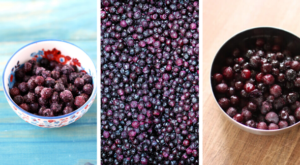Wild Blueberry Press Release
The best addition to your grocery cart: frozen wild blueberries
January 17, 2020
The best addition to your grocery cart: frozen wild blueberries
It is a common misconception that food loses its natural taste and nutritional value when it is frozen – but when it comes to wild blueberries, this is not the case. Wild blueberries are frozen at the peak of ripeness locking in their taste and nutrition. The vast majority of Canada’s wild blueberry crops grow in the cold harsh climate of Eastern Canada and are immediately quick frozen upon harvest so that they can easily be distributed to food producers and grocery stores throughout the country.
Despite their small size, wild blueberries are a top antioxidant fruit containing more anthocyanins than their high bush cultivated counterparts. Anthocyanins combat disease and promote healthy aging – making them the perfect addition to the family’s healthy eating regimen.
At a time of year when many are focused on healthy eating goals, these are three fact-based reasons why frozen wild blueberries should always make it into one’s grocery cart.
Wild born and bred by Mother Nature
Wild blueberries are different than the ordinary blueberry. Wild blueberries are much smaller than cultivated berries and grow on low-bush plants. Most of the plant grows underground in a rhizome root system. This underground root system is how the plant spreads in the fields, called barrens. They are slow growing (it can take years to fill a small open patch) and are not manipulated by those who tend the crop. Fields may contain thousands of different varieties of these tiny berries, ranging in color from light to dark blue and in flavor from sweet, to tart, to tangy and because the different berries are harvested together, every mouthful is bursting with a more intense wild blueberry flavor. Ordinary blueberries have been modified to create larger berries and higher yields. They are planted in rows, tend to be taller and grow in most fields and there may be only one or two varieties per crop. They are found regularly in the fresh produce section, but to experience the full flavor of the wild blueberry year-round one needs to look in the supermarket’s frozen fruit section.
Little berry that packs a big health punch
It is immediately evident that wild blueberries are smaller than cultivated blueberries. A smaller berry means that with every bite one gets more berries. Every serving is packed with 21 per cent of one’s daily fibre (something most do not get enough of in their diets), is low in fat, and is an excellent source of manganese, making this tiny berry the perfect nutritional addition to any dish. Wild blueberries also contain 33 per cent more anthocyanins than ordinary blueberries. Anthocyanins help protect wild blueberries from the damage of ultraviolet light and other environmental stressors. A growing body of research indicates anthocyanins are good for humans, too.
Anthocyanins are found in the dark blue skin of the wild blueberry. They’re the plant compound responsible for giving wild blueberries their deep, rich purply blue hues and powerful antioxidant capacity. In fact, wild blueberries have twice the antioxidant capacity of ordinary blueberries. Although scientists still aren’t sure how or why anthocyanins prevent disease, it has been linked to their antioxidant properties. Two decades of research suggest that anthocyanins may play an important role in helping reduce the risk of cardiovascular disease, cancer, and cognitive decline. Discover some clever ways to introduce wild blueberries into everyday meals.
Four seasons of convenience
Wild blueberries are typically “in season” during the summer months, but because they are also quick frozen one can enjoy their freshness all year round. Research shows frozen fruit is often nutritionally superior to its fresh counterpart, and frozen wild blueberries are no exception. While fresh blueberries may travel for two weeks to arrive in the grocery store from the time they’re picked, wild blueberries are frozen within 24 hours of harvest. Luckily, delicious wild blueberries can be found nationally in the frozen fruit section of grocery stores year-round.
To learn more, visit the Frozen is Fresher infographic here.
About the Wild Blueberry Association of North America
The Wild Blueberry Association of North America (WBANA) is an international trade association of growers and processors of wild blueberries from Quebec, New Brunswick, Nova Scotia, Prince Edward Island, Newfoundland and Maine, dedicated to bringing the wild blueberry health story and unique wild advantages to consumers and the trade worldwide. For news, recipes, and related health information about wild blueberries visit www.wildblueberryassociation.ca or www.wildblueberries.com. For the latest updates, read the blog. Visit us on Facebook, Twitter, or Instagram.
-30-
For more information, recipes, visuals or to schedule an interview with Chef Christine Tizzard or the Wild Blueberry Association of North America, please contact Ruth Colapinto or Susan Willemsen at The Siren Group Inc. Tel: (416) 461-5270. Email: ruth@thesirengroup.com or susan@thesirengroup.com. Visit www.thesirengroup.com or on Facebook, Twitter and Instagram @thesirengroup.
Bottom of Form



